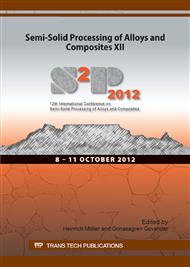p.142
p.149
p.155
p.161
p.167
p.173
p.179
p.185
p.191
Property and Quality Optimization of Laser Welded Rheo-Cast F357 Aluminum Alloy
Abstract:
F357, a hypo-eutectic Al-7%Si-0.6%Mg alloy without beryllium, was processed with CSIR-Rheo technology to the Semi-Solid Metal (SSM) state and cast in plates by means of High Pressure Die Casting. The castings were either left in the as-cast (F) condition or subjected to T4 or T6 heat treatments prior to autogenous Nd:YAG laser welding. A welding operating window was established and within this window, the weld porosity and undercut were minimised. Butt welds complying with ISO 13919-2: 2001 could be produced by means of the optimum parameters of 3.8 kW laser power and a welding speed of 4 m/min with a twin spot laser beam configuration. The mechanical properties of age-hardenable Al-Si-Mg alloys are dependent on the rate at which the alloy is cooled after the solution heat treatment. The low heat input provided by the laser welding process resulted in high enough cooling rates to ensure that both the fusion zone and HAZ were in the T4 condition after welding. Tensile properties equivalent to the parent metal in T6 condition were obtained after subjecting welded T4 plates to conventional artificial ageing treatment.
Info:
Periodical:
Pages:
167-172
Citation:
Online since:
October 2012
Authors:
Keywords:
Price:
Сopyright:
© 2013 Trans Tech Publications Ltd. All Rights Reserved
Share:
Citation:


